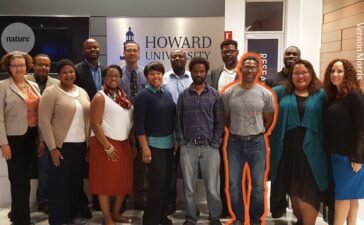The UK palaeontologist Richard Fortey — who spent his career at the Natural History Museum in London — was an expert on trilobites. These arthropods, distant relatives of today’s crustaceans and horseshoe crabs, went extinct at the end of the Palaeozoic era, some 250 million years ago. Fortey’s detailed fieldwork on trilobite ecology showed that those living in relatively shallow waters tended to be confined to the seas around the continent where they occur, whereas those that lived in deeper water were often distributed more widely. This insight enabled him to use trilobites and other fossils to constrain the position of the continents throughout time. He has died, aged 79.
While working at the museum, Fortey started writing books. Fossils, first published in 1982, serves mainly as an introduction to palaeontology for students. He subsequently sought a much wider audience with his books, including Life, published in 1998 — the story of the evolution of life on Earth told through his own experiences, bringing both fossils and their human investigators alive with descriptions and humorous anecdotes. By 2000, well-established, Fortey published Trilobite! “to allow my favourite animals to tell their stories in the detail they deserve”, followed by Earth, his geological history of our planet, in 2004.
Fortey was born in Ealing in west London and attended Ealing Grammar School for Boys. His father ran two fly-fishing shops, and Fortey developed his interest in natural history going on fishing trips to the chalk streams of Berkshire. He was admitted to the University of Cambridge, UK, graduating in natural sciences in 1968. After completing his PhD in 1970 at Cambridge’s Department of Earth Sciences, he moved to the Natural History Museum.
As a boy, Fortey took the first fossil he found — an ammonite from Dorset on the south coast of England — to the Natural History Museum to be identified. His first trilobite came later, in southern Wales, and the die was cast: “If you can have love at first sight, then I fell in love with trilobites at the age of fourteen.”
From a pocketful of rocks to scientific director of palaeontological research
As a 21-year-old undergraduate, he joined an expedition to Spitsbergen, the largest island in the Svalbard archipelago, north of Norway. There, he and his companion collected a remarkable diversity of new trilobite species that they found in rocks from the Ordovician period (between 485 and 444 million years ago) — the perfect basis for his PhD project.
Fortey returned to Spitsbergen in 1971 to collect further samples, and his 499-page monograph on the trilobites was published by the Norwegian Polar Institute in 3 parts, between 1974 and 1980. He recognized three trilobite communities, each representing different environments and ocean depths, and a fourth that was dominated by swimmers, ranging across oceans.
He developed methods for interpreting how trilobites lived, not least from analysing their remarkable eyes. With his colleague Robin Cocks, Fortey recognized that locations of distinct faunas — particularly those that lived during the Ordovician — could be used alongside geophysical methods to reconstruct the distribution of tectonic plates.
You Might Also Like
The Nature Podcast highlights of 2025
You have full access to this article via your institution. Download the Nature Podcast 24 December 2025In this episode:00:40 What...
Seeding opportunities for Black atmospheric scientists
Vernon Morris (outlined) with alumni from the atmospheric sciences PhD programme he established at Howard University in Washington DC.Credit: Vernon...
peer reviews created using AI can avoid detection
The difficulty of detecting AI-tool use in peer review is proving problematic.Credit: BrianAJackson/iStock via GettyIt’s almost impossible to know whether...
I’ve earned my PhD — what now?
Illustration: David ParkinsThe problemDear Nature,In December 2024, I finished my PhD in biomedical chemistry in Italy, and I now find...











